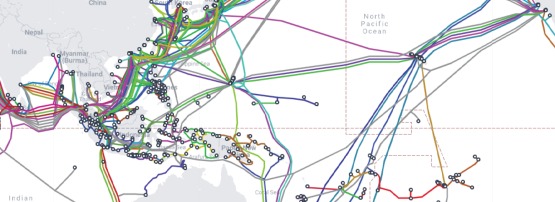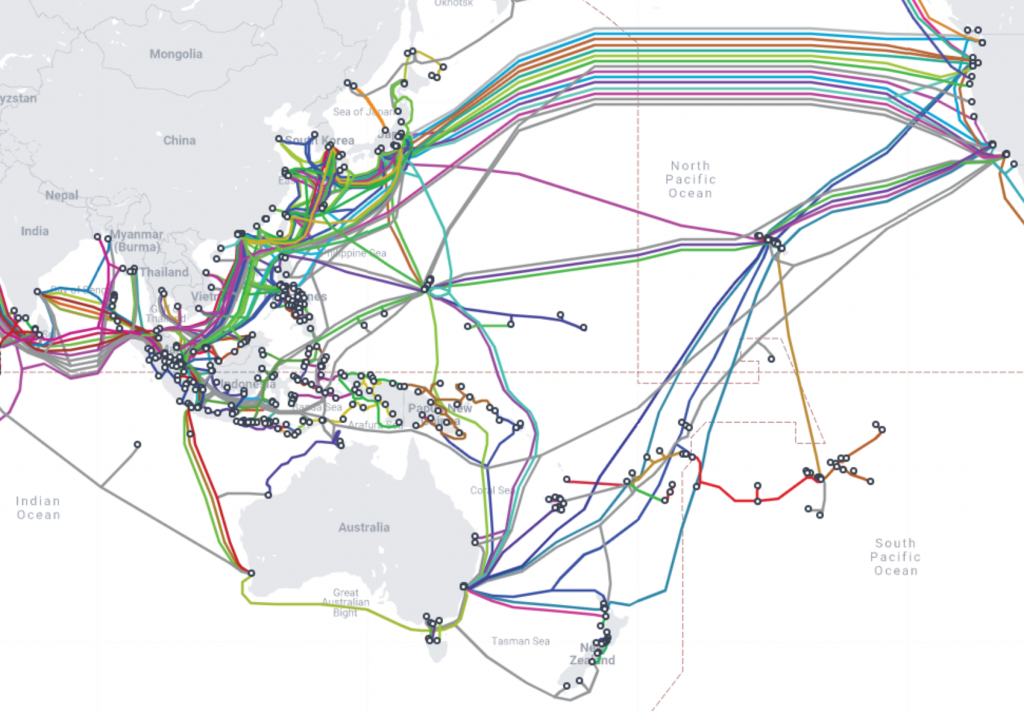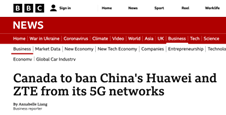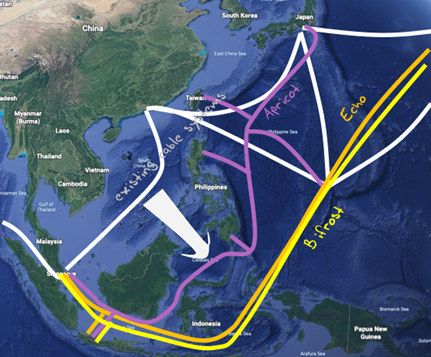
I must admit that I’m a keen follower of the analysis work done by Jon Brewer. He manages to pull together excellent research with valuable insights, and I look forward to his presentations. Jon can be found at Telco2.
The second half of this article, looking at the inventory of recent and near future submarine cables in the western Pacific uses his excellent presentation at the recent NZNOG 2022 conference in May as the primary source material, and I’d like to thank Jon here for his research into this topic and his insightful presentation.
Jon will be presenting on this topic at APNIC 54, in Singapore, in September.
There was a naïve idealism in the early days of the Internet that attempted to rise above the tawdry game of politics. Somehow, the Internet community thought it had managed to transcend a whole set of rather messy geopolitical considerations that plagued the telephone world and this new digital space the Internet was creating was simply not going to play by the old rules.
A good example of this thinking was the Declaration of the Independence of Cyberspace by John Perry Barlow in 1996. I won’t quote it all here, but the assertion ‘Cyberspace does not lie within your borders’ is a pretty good summary. However noble the aspirations of this early Internet may have been, such ideals were not going to last once the Internet consumed the mainstream of the telecommunications industry. Just to remind ourselves, communications is a massive activity sector, currently valued at 3 trillion dollars, and it should come as no surprise that this is a highly politicized space.
The early political tensions in communications technology were transatlantic tensions. Virtual circuit-based packet switching technologies, such as X.25 had a strong foundation in Europe, while IP was seen as a US technology. In the mobile communications world, Europe quickly embraced GSM technology while the US market clung to its CDMA system. For a while, the mobile market swung in Europe’s favour where Nokia became the dominant provider, but the pendulum swung back to the US with Apple’s iPhone and subsequently Google’s Android platform gaining market ascendency.
In recent years, this tension has shifted hemispheres and the Pacific region is now seeing an increase in these political tensions.
Several economies, including the Unites States, the United Kingdom, Australia, New Zealand, and most recently Canada have announced restrictions on the use of Chinese providers to build domestic service platforms, particularly their 5G mobile networks (Figure 1). Some of China’s biggest technology and telecommunications firms have been targeted in recent years by governments in the US and other Western nations over national security concerns.
These political tensions are not limited to mobile and broadband network platforms. The world of submarine cables in the Pacific is similarly being impacted by these tensions, as illustrated in Jon’s NZNOG presentation.
Submarine cable models
Funding a submarine cable in the telco era was a process of controlled release. Submarine cables were proposed by consortia telco operators, who would effectively become shareholders of a dedicated corporate vehicle that would oversee and finance the construction and operation of the submarine cable. The route of the cable reflected the majority of interests that were represented in that cable company. The cable could be a single point-to-point cable system, a segmented system that breaks out capacity at various waypoints along the cable path, or a multi-drop cable system that supported multiple point-to-point services.
The telco model of cable operation was driven largely by the mismatch between supply and demand in the telephone world. The growth in demand for capacity was largely based on factors of growth in population, growth in various forms of bilateral trade and changes in relative affordability of such services. These growth models are not intrinsically highly elastic. The supply model was based on the observation that the cost of the cable system had a substantial fixed-cost component and a far lower variable cost based on cable capacity. The most cost-effective approach was to build the largest capacity cable system that current transmission technologies could support.
The risk is entering cycles of boom and bust. When a new cable system is constructed, then placing the entire capacity inventory of the cable into the market in a single step would swamp the market and cause a price slump. Equally, small increments in demand within a highly committed capacity market would be insufficient to provide a sustainable financial case for a new cable system, so new demands would be forced to compete against existing use models, creating scarcity rentals and price escalation.
The cable consortium model was intended to smooth out mismatch between the supply and demand models. The cable company would construct a high-capacity system but hold onto this asset and release increments of capacity in response to demand, while attempting to preserve the unit price of purchased capacity. Individual telephone companies would purchase 15-to-30-year leases of cable capacity (termed an ‘Indefeasible Right of Use’, or IRU), which would provide a defined capacity from the common cable and commit the IRU holder to some proportion of the cable’s operating cost.
The cable company would initially be operated with a high level of debt but as demand picked up over time the expectation was that this debt would be paid back through IRU purchases, and the company would then shift into generating profit for its owners once it had achieved the breakeven level of IRU purchases.
In the telephone world, these capacity purchases would normally be made on a ‘half circuit’ model. Each IRU half circuit purchase would need to be matched with another IRU half circuit, such that any full circuit IRU was, in effect, jointly and equally owned by the two IRU holders.
This framework of cable ownership and operation did not survive the onslaught of Internet-based capacity demand. Since the 1990s, the Internet has been growing along the lines of a demand-pull model of unprecedented proportions. Over the past three decades the aggregate levels of demand for underlying services has scaled up by up to eleven orders of magnitude. Today’s Internet is larger by a factor of a hundred billion, or more than the networks of the early 1990s. This rapid increase in demand exposed shortfalls in the existing supply arrangements, and the Internet’s major infrastructure actors have addressed these issues by working around them. The brokered half circuit model of submarine cable provisioning was rapidly replaced with models of ‘fully owned’ capacity, where a single entity purchased both half circuits in a single IRU transaction, and even to models of ‘fully owned cables’ where the cable company itself was fully owned by a single entity.
Submarine cable constraints
However, there are a few aspects of submarine cable systems that have not changed:
- Geology. Cable breaks are disruptive, expensive, and best avoided. The ideal environment for a submarine cable is a deep-sea floor path that avoids geologically active areas of the sea floor. Active undersea rift zones, fault zones, and areas that are prone to subsea landslides are best avoided. In general, deeper water is preferred, as shallow water is prone to cable snagging from other maritime activities.
- Distance. Shorter is better. The human factors behind telephony meant that once the end-to-end delay was under 300ms the humans at either end of a conversation perceived the interaction as immediate. Computers are far more discriminating, and every millisecond of delay matters. For that reason, shorter cable paths are preferred.
- Territory and politics. National jurisdictions do not stop at the low tide mark of a territory, they extend out into the sea and the sea floor. The 1982 United Nations Convention on the Law of the Sea (PDF) defined sovereign territorial waters as a 12-mile zone extending out from an economy’s coast. Every coastal economy has exclusive rights to the oil, gas, and other resources in the seabed up to 200 nautical miles from shore or to the outer edge of the continental margin, whichever is the further, subject to an overall limit of 350 nautical miles (650km) from the coast or 100 nautical miles (185km) beyond the 2,500-metre isobath (a line connecting equal points of water depth). What does this mean for submarine cables? The point where the cable enters territorial water surfaces requires the permission of the economy. It also implies that any cable construction and repair operations carried out in these sovereign areas also require the permission of the economy which has exclusive rights to the sea and seafloor.
Cable systems in the Pacific
For many years, the Pacific was a ‘transit zone’ where the major economies located on the rim of the Pacific Ocean constructed point-to-point cable systems to provide interconnections. The major cable hubs were on the west coast of North America, Japan, Hong Kong, and Singapore.
The result was a ‘two-speed’ Pacific, where the larger economies were linked using high-capacity and low-delay submarine cable infrastructure, and all the other Pacific communities had no option other than to use geostationary satellite services. It is only in recent years that we’ve seen cable systems proposed to perform ‘in-fill’ to install high-speed fibre cables to the smaller communities in the Pacific.
The current picture of cable systems in the Pacific is shown in Figure 2.

The focal points for regional cable connectivity are Hong Kong, Singapore, and Japan. Many cables lie under the South China Sea and traverse the Luzon Strait. Singapore acts as an East/West gateway for the cable network and, with a small number of exceptions, most trans-Pacific cables use a northern route between Japan and the United States.
Recent Pacific cable proposals
The rise of content networks and the inexorable shift to cloud-based services has had a major effect on the demand models for carriage capacity. This is not necessarily expressed in the expansion of transit public Internet services, and these days the major content providers including Google, Meta, and Amazon are major actors in this space. These changes have created a demand-driven opportunity to extend the submarine cable network in the Asia Pacific region. However, this shift has exposed some unresolved tensions between China and the United States. Let’s look at how these tensions have emerged in a set of recent submarine cable proposals.
Solomons Islands cable
In 2012, the Asian Development Bank indicated that they would support a proposal to construct a spur on the PPC-1 cable to link the Solomon Islands with Sydney. Progress was slow, and four years later the Solomons Islands government set up a state-owned cable company to complete the cable. They decided to engage a vendor directly, and the Asian Development Bank withdrew its support for the project. In July 2017, Huawei Marine announced the signing of a contract with the Solomon Islands Submarine Cable Company to design and construct a 2.5Tb cable link between Honiara and Sydney, using a 4,000km submarine cable.
This project was seen as a step too far for the Australians, who were reported to be unwilling to have Chinese equipment interconnected with the Australia network. One year later, in August 2018, Australia announced it would fund a cable project, the Coral Sea Cable system, that would link Papua New Guinea and the Solomon Islands to Sydney, with the project being managed by an Australian entity, Vocus. They then selected Alcatel Submarine Networks as its cable provider and the system was completed in December 2019.
East Micronesia cable system
Support from the World Bank and the Asian Development Bank was proposed in 2017 for a cable system that would extend an existing cable system (HANTRU-1) between Guam, Micronesia, and the Marshall Islands with a link from Pohnpei to Kosrae in Micronesia, Nauru, and Tarawa, the capital of Kiribati. Alcatel Submarine, Huawei Marine, and NEC all lodged bids to construct this cable.
A Reuters news item in late 2020 reported that the United States warned Pacific Island nations about the security threats posed by Huawei Marine’s ‘cut price bid’ to construct this cable, echoing earlier concerns voiced by Nauru on the potential roles of Huawei Marine. The report mentioned the requirement placed on all Chinese firms to cooperate with China’s intelligence and security services, and the potential implications this had on regional security in this part of the Pacific. This was picked up by the United States, who voiced a similar warning on the potential security threats posed by the Huawei Marine bid to construct this cable. By mid-2021 the entire project had reached a stalemate and the project was ditched.
In December 2021, Australia, Japan, and the United States announced plans to fund a new cable linking the same three locations to HANTRU-1, like a replay of the Solomon Islands cable.
Pacific Light Cable Network
Many east-west trans-Pacific cables traverse the Luzon Strait, located between Taiwan and the Philippines. This is one of the few deep-water entrances in East Asia. Further north, the cable would have to run though the shallow continental shelf waters of the Taiwan Strait, and further south would mean a lengthy detour through the Philippines and the South China Sea to reach Hong Kong.
The Pacific Light Cable Network was a partnership between Google, Facebook, and the Chinese Dr Peng Group. It proposed to use 12,800km of fibre and an estimated cable capacity of 120Tbps, making it the highest-capacity trans-Pacific route at the time (2018), and the first direct Los Angeles to Hong Kong connection. The cable was completed in 2018, but a US Justice Department committee blocked approval of the Hong Kong connection on the United States side, citing ‘Hong Kong’s sweeping national security law and Beijing’s destruction of the city’s high degree of autonomy’ as a cause for concern, noting the cable’s ‘Hong Kong landing station could expose US communications traffic to collection by the PRC.’
In early 2022, the US FCC approved a license for a modified cable system that activated the fibre pairs between Los Angeles and Baler in the Philippines and Toucheng in Taiwan. The other four fibre pairs are unlit under the terms of this FCC approval.
Hong Kong – America Cable (HK-A)
The Hong Kong-America Cable System was a 6-fibre-pair submarine cable proposal, intending to connect Hong Kong and Taiwan with the United States directly, with an initial design capacity of 12.8Tbps for each fibre pair (for a total of 76.8Tbps) using 100Gbps coherent DWDM technology.
The HKA Consortium consisted of Facebook, China Telecom, China Unicom, RTI Express, Tata Communication, and Telstra. The supply contract was awarded to Alcatel Submarine. The HKA Consortium and ASN officially announced the launch of the HKA cable project at PTC 2018. The FCC application to land the cable in the United States was withdrawn in March 2021.
Hong Kong – Guam (HK-G)
The Hong Kong-Guam (HK-G) cable system was originally proposed in 2012 as a 3,700km undersea cable connecting Hong Kong to Guam. The HK-G cable system was proposed to have 4 fibre pairs, with design capacity of 48Tbps (12Tbps per fibre pair).
The FCC application to land the cable in Guam was withdrawn in November 2020.
Bay to Bay Express (BtoBE)
The Bay to Bay Express (BtoBE) consortium was composed of China Mobile International, Facebook and Amazon. It was proposed to be 15,400km trans-Pacific optical fibre submarine cable system connecting Singapore, Malaysia, Hong Kong, and the United States. The BtoBE cable system was to be supplied by NEC.
Considering the United States was no longer approving landings to direct connections between the United States and Hong Kong, the BtoBE consortium withdrew the application for cable landing license on 10 September 2020.
The next round of cables
The demand for further capacity across the Pacific Ocean continues, but with the current United States position on withholding United States landing approval for cables that terminate in China or Hong Kong, and with the unresolved international issues in the South China Sea, any new cable proposals that cross the Pacific either must use the northern routes and connect to Japan or use a more southerly route that passes south of Kalimantan to reach Singapore.
Apricot
Apricot is a 12,000km cable system that provides north-south connectivity along the western Pacific Rim with landing points in Japan, Taiwan, Guam, Philippines, Indonesia, and Singapore and will have a capacity of 190Tbps. The Apricot consortium comprises Facebook, Google, NTT, Chunghwa Telecom (CHT), and PLDT. The cable system is being constructed by NTT.
Echo
Echo is a 144Tbps 16,206km east-west trans-Pacific cable system connecting Singapore and Indonesia to the United States, with a branching connection to Guam. The cable system will be supplied by NEC. Google and Facebook will own half the cable capacity each. The current ready-for-service date is listed as 2023.
This is the first direct Singapore – United States cable connection, but it’s by no means the last.
Bifrost
Bifrost is an east-west trans-Pacific cable system connecting Singapore, Indonesia, and the Philippines to the United States with a branching connection to Guam. The cable is being constructed by Alcatel Submarine, with a ready for service date listed as 2024. The cable is a 12-pair system.
The Bifrost consortium comprises Facebook, PT. Telekomunikasi Indonesia International (Telin), and Keppel Telecommunications & Transportation Limited (Keppel T&T).
The new cable map of the Pacific
There is a realignment in the western Pacific with new submarine communications systems shifting east from the South China Sea and the Luzon Strait and instead using the Celebes Sea, the Banda Sea, and the Philippine Sea.
Hong Kong will no longer be the focal point for western Pacific connections in the coming years. Instead, the focus appears to be concentrating on Japan, Guam, and Singapore, with Guam becoming a highly critical nexus of regional infrastructure (Figure 3).
The open question here is how China will respond to these changes. This is not just a cable route question, or a question about the future roles of Chinese technology providers such as Huawei and ZTE in the global markets, but a larger question about the way in which the China-based digital giants, such as Alibaba and Tencent will engage in these massive digital markets. There is much shrouded in a veil of uncertainty about the near- and medium-term futures.
As has happened many times in history, the introduction of radically new technologies into human society and the massive societal changes they induce creates change, uncertainty, and disruption to the old orders. In such times, any predictions of the future are little more than wild guesses!
The views expressed by the authors of this blog are their own and do not necessarily reflect the views of APNIC. Please note a Code of Conduct applies to this blog.


